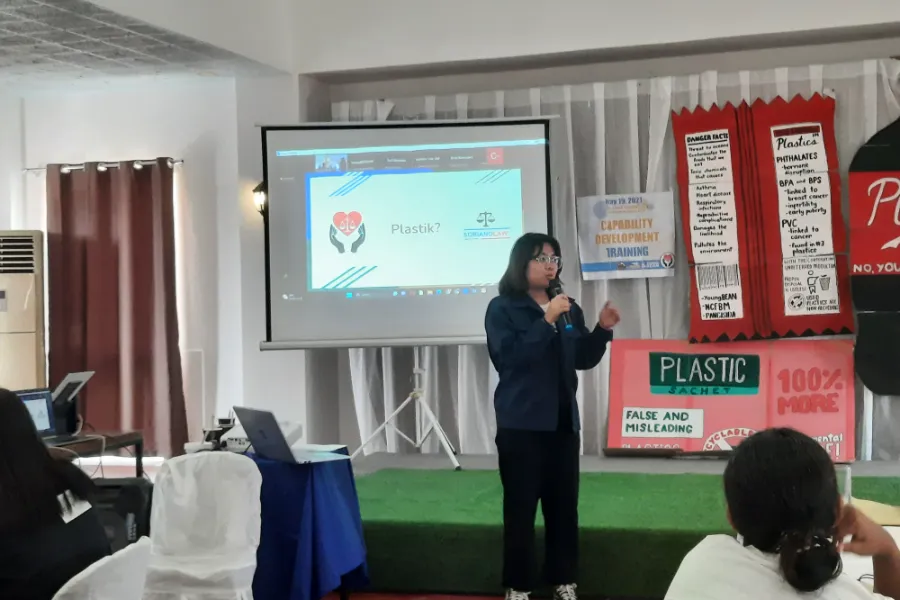The (Un)true Friend
By: C-Help Team
Riddle: It is seen everywhere, it is used every day, everyone thinks it is their friend but it is not.
Answer: Plastic.

Some say, the very first plastic was created in 1862 and plastic bottles made of PET began to be produced in 1977. During this time, plastic was seen as the new revolutionary product in packaging.[1] It was mainly invented to substitute the limited natural resources. Shortages arose as society grew and consumerism increased.[2]
Plastics is now more preferred to be used by fast moving consumer goods companies because it is cheap, light-weight, water resistant and flexible. Everything is wrapped with plastic; from the tiniest to the largest product.
Problem is, plastic is harmful to health and damaging to the environment.
Microplastics are already found in human blood. It runs through veins and damages human health.
An alarming report from The Guardian that microplastic pollution has been detected in human blood for the first time, with scientists finding the tiny particles in almost 80% of the people tested. [3]
In the said report, huge amounts of plastic waste are dumped in the environment and microplastics now contaminate the entire planet, from the summit of Mount Everest to the deepest oceans. People were already known to consume the tiny particles via food and water as well as breathing them in, and they have been found in the faeces of babies and adults.
Hazardous substances such as polybrominated diphenyl ethers, phthalate plasticizers, grease, polyfluoroalkyl substances, ultraviolet stabilizers as well as heavy metals such as cadmium and lead are used in making plastics. According to EcoWaste Coalition, these hazardous substances leach into food, soil and water.
The new research entitled Discovery and Quantification of Plastic Particle Pollution is published in the journal Environment International[4]. It adapted existing techniques to detect and analyze particles as small as 0.0007mm. Some of the blood samples were found to contain two or three types of plastic.
Plastic leaks into the ocean.
According to the Breaking the Plastic Wave Report, by modeling analysis, in the next 20 years, plastic waste generation will double, plastic leakage into the ocean will nearly triple, and plastic stock in the ocean will more than quadruple. The cost of inaction is high:
“The Business As Usual Scenario presents multiple risks, and the cost of inaction is high—to the marine environment, to human health and communities, and to business. The direct threats to marine wildlife, circulation of invasive species, and contamination of aquatic food chains caused by an additional 450 million metric tons of plastic stock in the ocean could reduce the productivity of fisheries and aquaculture, and degrade the function of aquatic ecosystems and the scientific and cultural services of marine environments. Higher levels of plastic production and mismanaged waste are also a threat to human health. Some of the most harmful risks stem from open burning, which is expected to nearly triple under BAU, from 49 million metric tons in 2016 to 133 million metric tons in 2040, increasing the release of persistent toxic chemicals that can increase the risk of heart disease, cancer, respiratory infections and asthma, reproductive health complications, and damage to the central nervous system. In addition, studies have identified microplastics in foodstuffs, and microplastics also have been reported in the tissues of terrestrial and marine invertebrates, fish, and even humans. BAU would result in an expected 2.4-fold growth in primary microplastic leakage into the ocean, the potential long-term consequences of which are still being studied.
According to a 2021 World Bank study, 2.7 million tons of plastic waste are generated in the Philippines each year.
Globally, only 9% of consumed plastics are recycled[5]. Most plastics are leaked to the environment and/or disposed of.
The undeterred production and use of plastic packaging contributes, in a major way, to the massive plastic pollution in the Philippines and the world because it is not recyclable, contrary to the manufacturers’ claim. The plastics end up on dump sites, landfills, streets, drains, creeks, rivers and seas or are burned, causing health, safety, livelihood and environmental problems to Filipinos.
In sum, plastic is our untrue friend.
To read more about the dangerous and hazardous effects and impacts of plastic packaging to human health and environment you can go to these links below:
Microplastic pollution found near summit of Mount Everest | Plastics | The Guardian
Plastic pollution discovered at deepest point of ocean | Plastics | The Guardian
People eat at least 50,000 plastic particles a year, study finds | Plastics | The Guardian
Plastic fibres found in tap water around the world, study reveals | Plastics | The Guardian
Revealed: microplastic pollution is raining down on city dwellers | Plastics | The Guardian
More microplastics in babies’ faeces than in adults’ – study | Medical research | The Guardian
Discovery and quantification of plastic particle pollution in human blood - ScienceDirect
[1] Retrieved from https://www.shilohplastics.com.au/history-of-plastic/
[2] Ibid.
[3] See full article at https://www.theguardian.com/environment/2022/mar/24/microplastics-found-in-human-blood-for-first-time
[4] PDF of the study was accessed on 04 Nov. 2022 from https://www.sciencedirect.com/science/article/pii/S0160412022001258
[5] OECD (2022), Global Plastics Outlook: Economic Drivers, Environmental Impacts and Policy Options, OECD Publishing, Paris, https://doi.org/10.1787/de747aef-en.
